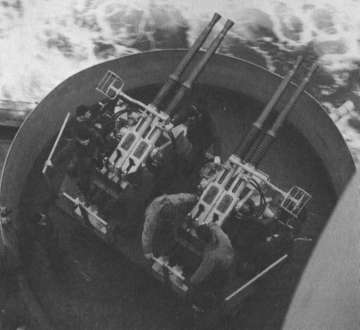

A startling improvement over the Navy's old 1.1-inch (27.94mm) AA weapon, the USN acquired some of these, mounting them in submarines, destroyers, and some lighter vessels. Later that year a twin-barrelled example arrived from Sweden via Finland and, using British and Dutch plans, the York Lock & Safe Co. undertook to manufacture them for the Navy, though it did not receive formal licence from Sweden to do so until June of 1941. The first twin Bofors was produced in January of 1942. A quadruple version followed in April, and in June it was mounted in USS Wyoming, an old battleship used for gunnery training. On 1 July the first production twin was installed in the destroyer Coghlan, and Bofors guns soon were appearing fleet-wide, though not until mid-1944 was demand satisfied.
During
her post-Eastern Solomons repair at Pearl Harbor, the carrier Enterprise
received 16 of them, used to dramatic effect at the Battle of Santa
Cruz, where they ripped apart most of the planes the Japanese hurled at
her.
Though a tactical defeat
for the Americans due to the loss of USS Hornet, it proved a strategic
victory, because none of the Japanese carriers retained enough aircraft
to continue operations.
The 40mm L/56 came in two basic mountings, the smaller being a twin-barrelled version used mostly in destroyers and lighter craft. The large quadruple mount, basically two twins side-by-side, due to its weight was found primarily in carriers, battleships, and cruisers, though the new Gearing-class destroyers got three quads and two twins.
The efficient
40mm proved adequate for all close-in air defence duties until the kamikaze
attacks of the last nine months of the war. Despite its firing rate of
160 rounds per minute per barrel, achieved by using four-round clips of
ammunition that could be inserted from the top of the gun even while it
was firing, it was not devastating enough to stop many diving suicide
planes from crashing into their targets. Part of the problem was that the
40mm couldn't handle the VT proximity fuse, the 76mm guns being the smallest
weapons able to handle that devastating item. That experience quickly invoked
design of an anti-kamikaze 76mm AA gun, but it did not become available
until well after the war. The famed Bofors 40mm remained the close-in anti-aircraft
weapon of large ships and the primary one of smaller vessels until the
Japanese surrender.
|
|
Year of Construction:
1942
Bore: 40mm Weight of gun: 522kg / 1150lbs Weight of barrel: 91.6kg / 202 lbs Length of gun: 3,779.5mm / 148.8 ins. Length of bore: 2,250mm / 88.853 ins. (56 calibers) Wt. of projectile: 0.9 kg / 1.985 lbs Max. Range: 10.1 km / 11.000 yds at 42° elevation Ceiling: 6.950 km / 22.800 ft. at 90° elevation Max. Elevation: 90° Rate of Fire: 160 rounds/min |